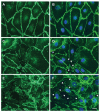Circulating Extracellular Vesicles and Endothelial Damage in Sickle Cell Disease
- PMID: 33013455
- PMCID: PMC7495019
- DOI: 10.3389/fphys.2020.01063
Circulating Extracellular Vesicles and Endothelial Damage in Sickle Cell Disease
Abstract
Endothelial damage is central to the pathogenesis of many of the complications of sickle cell disease. Circulating extracellular vesicles (EVs) have been implicated in modulating endothelial behavior in a variety of different, diseases with vascular pathologies. As seen in other hemolytic diseases, the plasma of sickle cell patients contains EVs of different sizes and cellular sources. The medium-sized vesicles (microparticles) primarily derive from mature red blood cells and platelets; some of these EVs have procoagulant properties, while others stimulate inflammation or endothelial adhesiveness. Most of the small EVs (including exosomes) derive from erythrocytes and erythrocyte precursors, but some also originate from platelets, white blood cells, and endothelial cells. These small EVs may alter the behavior of target cells by delivering cargo including proteins and nucleic acids. Studies in model systems implicate small EVs in promoting vaso-occlusion and disruption of endothelial integrity. Thus, both medium and small EVs may contribute to the increased endothelial damage in sickle cell disease. Development of a detailed understanding of the composition and roles of circulating EVs represents a promising approach toward novel predictive diagnostics and therapeutic approaches in sickle cell disease.
Keywords: endothelial damage; exosomes; extracellular vesicle; microvesicle; sickle cell disease.
Copyright © 2020 Lapping-Carr, Gemel, Mao and Beyer.
Figures


Similar articles
-
Circulating Small Extracellular Vesicles May Contribute to Vaso-Occlusive Crises in Sickle Cell Disease.J Clin Med. 2022 Feb 3;11(3):816. doi: 10.3390/jcm11030816. J Clin Med. 2022. PMID: 35160266 Free PMC article.
-
Extracellular Vesicles in Sickle Cell Disease: A Promising Tool.Bioengineering (Basel). 2022 Sep 5;9(9):439. doi: 10.3390/bioengineering9090439. Bioengineering (Basel). 2022. PMID: 36134985 Free PMC article. Review.
-
Extracellular Vesicles in Sickle Cell Disease: Plasma Concentration, Blood Cell Types Origin Distribution and Biological Properties.Front Med (Lausanne). 2021 Aug 20;8:728693. doi: 10.3389/fmed.2021.728693. eCollection 2021. Front Med (Lausanne). 2021. PMID: 34490315 Free PMC article. Review.
-
Extracellular vesicles and blood diseases.Int J Hematol. 2017 Apr;105(4):392-405. doi: 10.1007/s12185-017-2180-x. Epub 2017 Jan 27. Int J Hematol. 2017. PMID: 28130731 Review.
-
Extracellular vesicles characteristics and emerging roles in atherosclerotic cardiovascular disease.Metabolism. 2018 Aug;85:213-222. doi: 10.1016/j.metabol.2018.04.008. Epub 2018 May 1. Metabolism. 2018. PMID: 29727628 Review.
Cited by
-
Platelet-Derived Procoagulant Microparticles as Blood-based Biomarker of Breast Cancer.Asian Pac J Cancer Prev. 2021 May 1;22(5):1573-1579. doi: 10.31557/APJCP.2021.22.5.1573. Asian Pac J Cancer Prev. 2021. PMID: 34048188 Free PMC article.
-
Pathophysiology of Coagulation and Emerging Roles for Extracellular Vesicles in Coagulation Cascades and Disorders.J Clin Med. 2022 Aug 22;11(16):4932. doi: 10.3390/jcm11164932. J Clin Med. 2022. PMID: 36013171 Free PMC article. Review.
-
Mechanical stimuli such as shear stress and piezo1 stimulation generate red blood cell extracellular vesicles.Front Physiol. 2023 Aug 30;14:1246910. doi: 10.3389/fphys.2023.1246910. eCollection 2023. Front Physiol. 2023. PMID: 37719461 Free PMC article.
-
Role of endothelial dysfunction in sleep-disordered breathing in egyptian children with sickle cell disease.BMC Pediatr. 2024 Oct 1;24(1):626. doi: 10.1186/s12887-024-05066-6. BMC Pediatr. 2024. PMID: 39354381 Free PMC article.
-
Endothelial Dysfunction Linked to Ventricular Dysfunction in Children With Sickle Cell Disease, a 3D Speckle Tracking Study.J Saudi Heart Assoc. 2024 May 5;36(1):27-33. doi: 10.37616/2212-5043.1369. eCollection 2024. J Saudi Heart Assoc. 2024. PMID: 38873326 Free PMC article.
References
Publication types
LinkOut - more resources
Full Text Sources
Research Materials

